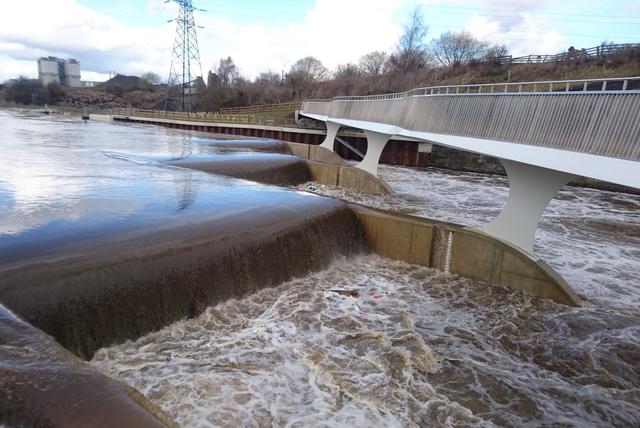Leeds Flood Alleviation Scheme marks five-year anniversary
7th October, 2022 - 11:30

In the five years since the launch of the Leeds Flood Alleviation Scheme Phase 1, the scheme's interventions have protected 3,000 residential properties, 500 businesses and 22,000 jobs from flooding.
The scheme, which includes two state-of-the-art moveable wiers at Crown Point and Knostrop, as well as a series of linear defence walls and manual flood gates, has been readied for deployment over 100 times and operated eight times over the period, protecting the city centre from damaging flooding.
Storm Ciara in 2020 resulted in the second highest levels ever recorded on the river Aire (2.06m). In 2022, storms Dudley, Eunice and Franklin brought similarly high river levels (1.97m), but in both instances the scheme (known as Leeds FAS1) served its purpose successfully.
FAS1 provides up to a 1-in-100-year standard of protection (or 1% annual exceedance probability), including a climate change allowance up to 2069.
The scheme’s success can be attributed both to its cutting-edge design and delivery, but also to the hard work of Leeds City Council’s Flood Risk Management team working closely with the Leeds City Council Resilience & Emergencies team, the Environment Agency and the Canal Rivers Trust.
The scheme is monitored by Leeds City Council staff 24/7 365 days a year, with continued maintenance and drills to ensure it is ready to operate when needed. There is also a team of around 25 trained specialists on call to operate the FAS during a flooding event.
Phase 2
The works to protect Leeds from flooding continue with phase 2 of the Leeds Flood Alleviation scheme (Leeds FAS2). Projected to complete in 2023, the engineering elements of the scheme stretch from Leeds Railway Station, up to Apperley Bridge, with a catchment-wide natural flood management scheme running from Leeds through to Malham and the source of the River Aire.
Once complete, the scheme will protect a further 1,048 homes and 474 businesses as well as increasing the level of protection for the whole of the FAS2 and FAS1 area to 1-in-200-year standard of protection (0.5% annual exceedance probability).
The natural flood management works, which have already planted over 400,000 trees to date, will ensure that the scheme is protected against the effects of climate change up to 2069 as well as offering a range of environmental benefits like carbon capture, biodiversity and more throughout a large portion of West Yorkshire.
Alongside Leeds FAS2, there are a range of smaller projects designed to protect specific areas at risk across the Leeds City Region including Churwell, Wortley, Meanwood, Thorner, Potternewton, Wetherby and more.
Climate change impact
Leeds City Council executive member for infrastructure and climate Councillor Helen Hayden said: “Our works to increase the flood resilience of Leeds help the city to adapt to the effects of climate change, and they are a key part of our response to the climate emergency. The Leeds FAS1 has been used more times than was originally projected at the planning stage, and this is likely to increase as the effects of climate change continue to grow.
"That is why we are committed not only to the hard defences to protect Leeds now, but also to natural flood management techniques at a large scale. This includes the planting of up to two million trees and innovative land management techniques that will slow the flow of water coming from the whole catchment, create habitat for wildlife, areas of woodland for residents to enjoy and increase the efficiency of our farmland."
Individual action still needed
Despite the effectiveness of the works to alleviate flooding in Leeds, there are steps that everyone can take to plan ahead and better protect themselves from the impact of flooding. This winter, Leeds City Council will be promoting guidance across its social media channels to encourage all Leeds residents and business owners to:
- Create a flood plan for your home or business using the template from the Environment Agency
- Sign up for flood alerts in your area for free on gov.uk
- Read guidance on the different types of flood warnings, and what they mean for your home or your travel plans


